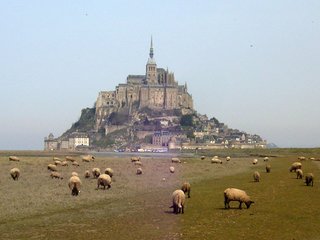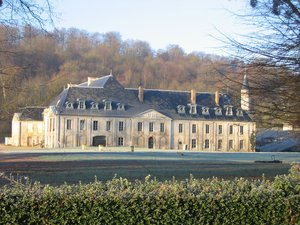Normandy
|
|
- For other uses, see Normandy (disambiguation).
Normandy is a geographical region in northern France. Upper Normandy (Haute-Normandie) consists of the French départements of Seine-Maritime and Eure, and Lower Normandy (Basse-Normandie) of the départements of Orne, Calvados, and Manche.
The Duchy of Normandy is a formerly independent duchy situated in northern France occupying the lower Seine area, the Pays de Caux and the region to the west through the Pays d'Auge as far as the Cotentin Peninsula. Normandy was historically a province of France.
The Channel Islands, although British, are culturally and historically a part of the Duchy of Normandy that never reverted to the crown of France.

| Contents |
|
|
Population
Normandy has 3.2 million inhabitants, with an average population density of 107 per square kilometer, just under the French national average, but rising to 145 for upper Normandy. The principal cities are Rouen (population 385,000, including suburbs), the capital of upper Normandy and formerly of the whole province; Le Havre (247,000); Caen (200,000), the capital of lower Normandy; and Cherbourg (89,000).

Other towns include:
- Alençon
- Arromanches
- Avranches
- Bayeux
- Coutances
- Dieppe
- Évreux
- Falaise
- Honfleur
- Lisieux
- Mortain
- Saint-Lô
- Saint-Sauveur-le-Vicomte
- Sainte-Mère-Église
- Villers-Bocage
Geography
The region is bordered along the northern coasts by the English Channel. Granite cliffs in the west and limestone cliffs in the east frame long stretches of beach in the centre of the region. The bocage, patchwork of small fields with high hedges, typical of the western areas caused problems for the invading forces in the Battle of Normandy. The meanders of the Seine as it approaches its estuary form a notable feature of the landscape.
Regions
- The Suisse normande (Norman Switzerland), in the south, presents hillier terrain.
- The Pays d'Auge is considered typical of the rich agricultural landscape of central Normandy.
- The Roumois
- The Lieuvin
- The Cotentin Peninsula
- The Pays de Caux
- The Bessin
- The Pays d'Ouche
- The Norman Vexin
Rivers
Rivers in Normandy include:
- the Seine
- the Orne
- the Vire
- the Eure
- the Risle
- the Robec
- the Touques
- the Couesnon, which traditionally marks the boundary between the Duchy of Brittany and the Duchy of Normandy.
The Pont de Normandie crossing the estuary of the Seine is regarded as a feat of modern engineering.
History
Jumièges.jpg
Normandy was the home of the Normans in the early Middle Ages, the last people to successfully invade England. The Normans were a mixture of the indigenous Gauls and of the Viking invaders under the leadership of Rollo (Gange Rolf), who besieged Paris and was given the area of Normandy (Treaty of St.-Claire-sur-Epte, 911) in return for defending it against future pirate attacks.
Rollo's descendant William, Duke of Normandy, invaded England in 1066 and became king William I of England. Normandy remained associated with England until 1087, in 1106-1144 and in 1154-1204. Also see the Battle of Bouvines in 1214. Normandy was occupied by English forces during the Hundred Years' War in 1346-1360 and again in 1415-1450.
Norman families, such as that of Tancred of Hauteville played important parts in the Crusades.
Both Wace and Orderic Vitalis are important Norman writers for the history of the province.
During World War II, the town of Dieppe was the site of the ill-fated Dieppe Raid by Canadian and British units in 1942. Later, Normandy was also the site of the Normandy Invasion or Operation Overlord that began on June 6, 1944, which day is also known as D-Day. This was the successful invasion of German-occupied France by U.S., British, and Canadian troops. Caen and other Norman towns endured many casualties in the fight for the province, which continued until the liberation of Le Havre on (September 12).
Channel Islands
Since the Channel Islands have remained loyal to the English Crown since the division of Normandy in 1204, yet are not part of the UK but rather the Duchy of Normandy, the British monarch (currently Queen Elizabeth II) is toasted as Duke of Normandy. However, she is not regarded as Duke of Normandy outside her realms since claims by English monarchs to the title were given up by the Treaty of Paris of 1259. Additionally, the rights of succession to that title are subject to Salic Law, which does not allow for female inheritance of the ducal title.
Culture
Languages
The Norman language, a regional language, is spoken by a minority of the population, especially in the Cotentin peninsula in the far West and in the Pays de Caux in the East. Many place names show the influence of this Norse-influenced oïl language; for example -bec (stream), -fleur (river), -hou (island), -tot (homestead).
NefStGeorges1.jpg
Arts
Architecture
- Main article is Architecture of Normandy.
Architecturally, Norman cathedrals, abbeys (such as the Abbey of Bec) and castles characterise the former Duchy in a way that mirrors the similar pattern of Norman architecture in England following the Norman Conquest of 1066.
Domestic architecture in upper Normandy is typified by half-timbered buildings that also recall vernacular English architecture, although the farm enclosures of the more harshly landscaped Pays de Caux are a more idiosyncratic response to socio-economic and climatic imperatives. Much urban architectural heritage was destroyed during the Battle of Normandy in 1944 - post-war urban reconstruction, such as in Le Havre and Saint-Lô, could be said to demonstrate both the virtues and vices of modernist and brutalist trends of the 1950s and 1960s.
Vernacular architecture in lower Normandy takes its form from granite, the predominant local building material. The Channel Islands also share this influence - Chausey was for many years a source of quarried granite, including that used for the construction of Mont Saint Michel.
Literature
Writers in the French language connected with Normandy include:
- Pierre Corneille
- François de Malherbe
- Jules Barbey d'Aurevilly
- Marcel Proust
- Guy de Maupassant
- Alphonse Allais
- Gustave Flaubert
- Jacques Prévert
- André Gide
- Raymond Queneau
- Jean Bertaut
- François le Metel de Boisrobert
- Casimir Delavigne
- Rémy de Gourmont
- Jean de Rotrou
- Octave Feuillet
- Jack Quesnot Monnier
See also Anglo-Norman literature
Painting
From the 1860s, plein-air painters, who worked outside the studio, were attracted to Normandy by the ease of railway access from Paris. Claude Monet's waterlily garden at Giverny is one of the most popular tourist attractions in the region. Eugène Boudin's paintings of fashionable seaside scenes are also typical.
RouenCathedral_Monet_1894.jpeg
Artists Norman by birth include:
- Nicolas Poussin
- Jean-François Millet
- Marcel Duchamp
- Fernand Léger
- André Breton
- Raoul Dufy
- Théodore Géricault
- Jean Dubuffet
- Georges de Scudéry
- Madeleine de Scudéry
Music
Erik Satie, Daniel Auber, Arthur Honegger and Marcel Dupré, composers, were born in Normandy.
Design
Christian Dior, fashion designer, was born in Granville.
Religion
The cathedrals of Normandy have exerted influence down the centuries in matters of both faith and politics. Mont Saint Michel is a historic pilgrimage site. The influence of Celtic Christianity can still be found in the Cotentin.
Many saints have been revered in Normandy down the centuries, including:
- Thérèse de Lisieux whose cult in Lisieux is a focus for religious devotion
- Joan of Arc who was martyred in Rouen, and who is especially remembered in that city
- Helier and Samson of Dol who are evangelizers of the Channel Islands
- Saint Marcouf and Saint Lô who are important saints in Lower Normandy
- St. Aubert who is remembered as the founder of Mont Saint Michel
- Thomas Becket, an Anglo-Norman whose parents were from Rouen, who was the object of a considerable cult in mainland Normandy following his martyrdom
Normandy does not have one generally-agreed patron saint, although this title has been ascribed to Saint Michael, and to Saint Ouen.
Food and drink
Normandy is famous for its rich, rolling countryside, which provides plentiful pasture for dairy cattle and orchards for apples. The dairy produce of the region is renowned: its cheeses are world famous and include Camembert, Livarot and Pont l'Evêque. Normandy butter is highly prized, as is Normandy cream, both of which are lavishly used in local gastronomic specialities.
Normandy is a major cider-producing region (very little wine is produced). Perry is also produced, but in less significant quantities. The apple brandy, of which the most famous variety is calvados, is also popular. The mealtime trou normand, or Norman break, is a pause between meal courses in which diners partake of a glassful of calvados, is still observed in many homes and restaurants. Pommeau is an aperitif produced by blending unfermented cider and apple brandy. Another aperitif is the kir normand, a measure of cassis topped up with cider. Benedictine is produced in Fécamp.
Apples are also used in cooking: for example, moules à la normande are mussels cooked with apples and cream, bourdelots are apples baked in pastry, and localities all over the province have their own variation of apple tart. A classic pastry dish from the region is Flan Normand a flaky pastry-based variant of the apple tart.
Other regional specialities include tripes à la mode de Caen, andouilles, teurgoule (spiced rice pudding) and seafood. Normandy is the most significant oyster-cultivating region in France.
Symbols
Norman_flags_on_parade.jpg
The traditional provincial flag of Normandy, gules, two leopards passant or, is used in both modern regions. The historic three-leopard version (known in the Norman language as les treis cats, "the three cats") is used by some associations and individuals, especially those who support reunification of the regions and cultural links with the Channel Islands and England.
The unofficial anthem of the region is the song "Ma Normandie."
See also
External links
- The Normans, a European People. The Norman heritage, 10th-12th century (http://www.mondes-normands.caen.fr/angleterre/index.htm)
- Gallery of photos of Normandy (http://www.offrench.net/photos/gallery-6.php)ang:Normandig
da:Normandiet de:Normandie es:Normandía eo:Normandio fr:Normandie id:Normandia it:Normandia nl:Normandië ja:ノルマンディー no:Normandie pl:Normandia pt:Normandia sk:Normandia sv:Normandie
